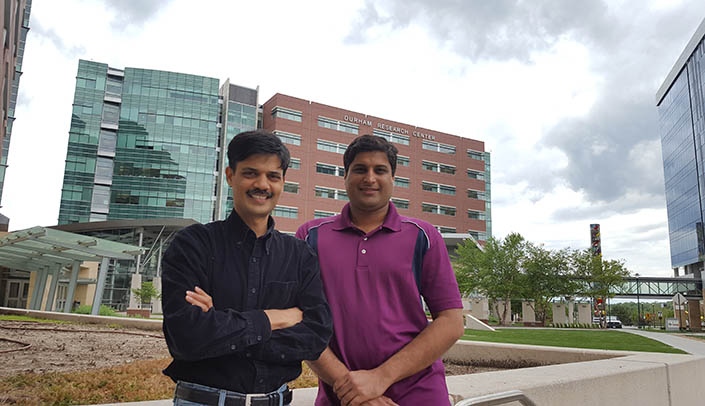Two UNMC scientists and their novel Easi-CRISPR genome-editing technology have contributed to a significant breakthrough in the fight against cancer.
The discovery may lead to new and safer treatments for autoimmune and other diseases, including rare inherited disorders.
UNMC’s Channabasavaiah Gurumurthy, D.V.M., Ph.D., associate professor of developmental neuroscience at Munroe-Meyer Institute, and Rolen Quadros, transgenic researcher in the Mouse Genome Engineering Core Facility, collaborated with researchers at the University of California, San Francisco (UCSF), to develop a technique in which they genetically reprogrammed T cells, the body’s foremost immune system fighter, to find and destroy cancer cells in mice.
The new method, described in the July 11 issue of Nature, offers a robust molecular “cut and paste” system to rewrite genome sequences in human T cells without using viruses to insert the DNA.
The collaboration began more than two years ago when Dr. Gurumurthy met Alex Marson, M.D., Ph.D., associate professor of microbiology and immunology, UCSF, and principal investigator of the study, at a scientific conference where they discussed the idea of using Easi-CRISPR strategy to engineer T cells.
Theo Roth, a student pursing M.D. and Ph.D. degrees in UCSF’s Medical Scientist Training Program and first author on the study, tested the idea and then did a series of other technical improvements to efficiently engineer T cells.
Before their breakthrough, numerous attempts by many researchers to place long sequences of DNA into T cells have not been effective. “The typical success rate of inserting longer DNA sequences into T cells is about one percent or less,” Dr. Gurumurthy said.
“Easi-CRISPR provided us one of the ways to develop an efficient strategy to insert longer DNA cassettes into T cells. With this method, we can take a cancer patient’s blood cells, isolate the T lymphocytes, manipulate the genome and train them to kill cancer cells, then transfer them back into the patient. Engineering a patient’s own T cells to find and kill cancer cells would be the most effective way of treating cancer,” he said.

Congrats to Guru and Rolen! This is really an exciting breakthrough! Kudos on being featured in Nature — what a great accomplishment!
Congratulations! What a wonderful achievement!
This is exciting news. Guru and Rolen are always pushing forward. I am proud to work with them. Congratulations on your success.